Macroeconomic Analysis: BHP Billiton's China Investment
VerifiedAdded on 2020/05/11
|44
|9608
|63
Report
AI Summary
This report provides a comprehensive macroeconomic analysis of China, focusing on its suitability as an investment destination for companies like BHP Billiton. It examines key indicators such as economic growth, business cycles, unemployment rates, average wage rates, human capital, inflation, real interest rates, government expenditures, domestic credit, taxation policies, infrastructure spending, exchange rate regimes, and monetary policies. The analysis considers the impact of the Global Financial Crisis and assesses the overall business environment in China. The report highlights China's strong trade and investment relationship with Australia, particularly in the mineral industry. The analysis concludes with recommendations for investment decisions based on the current macroeconomic conditions in China and its potential for long-term growth. The report is available on Desklib, a platform offering AI-powered study tools for students.
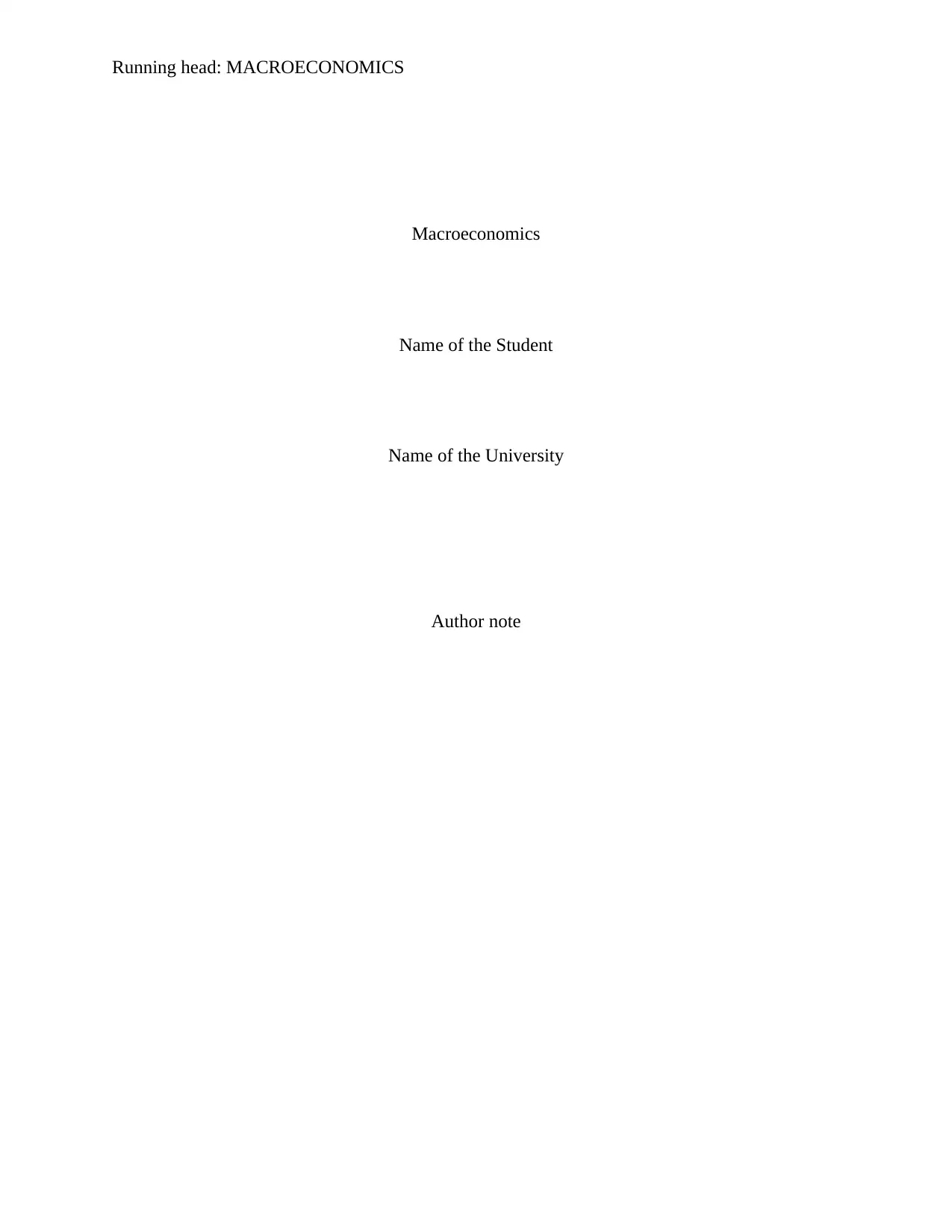
Running head: MACROECONOMICS
Macroeconomics
Name of the Student
Name of the University
Author note
Macroeconomics
Name of the Student
Name of the University
Author note
Paraphrase This Document
Need a fresh take? Get an instant paraphrase of this document with our AI Paraphraser
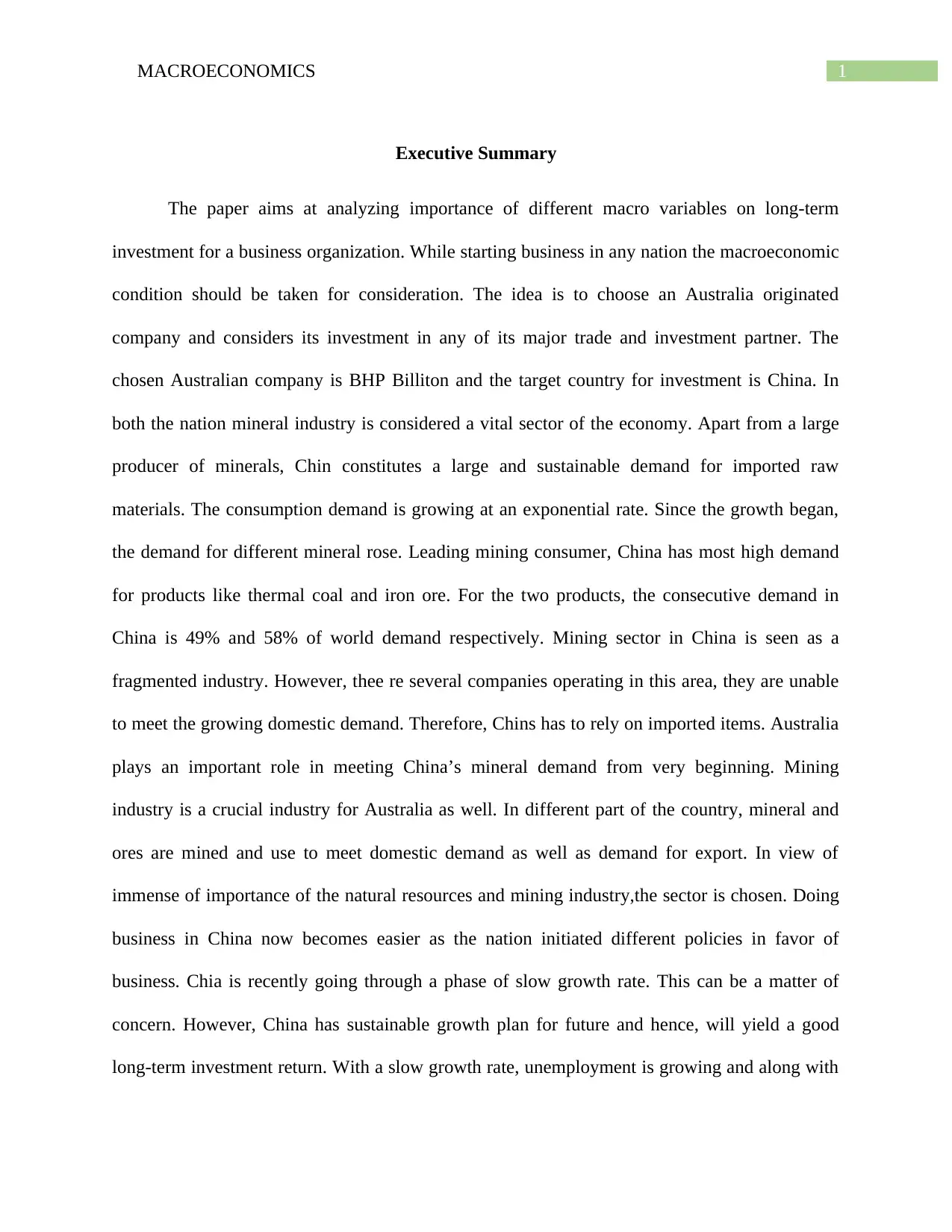
1MACROECONOMICS
Executive Summary
The paper aims at analyzing importance of different macro variables on long-term
investment for a business organization. While starting business in any nation the macroeconomic
condition should be taken for consideration. The idea is to choose an Australia originated
company and considers its investment in any of its major trade and investment partner. The
chosen Australian company is BHP Billiton and the target country for investment is China. In
both the nation mineral industry is considered a vital sector of the economy. Apart from a large
producer of minerals, Chin constitutes a large and sustainable demand for imported raw
materials. The consumption demand is growing at an exponential rate. Since the growth began,
the demand for different mineral rose. Leading mining consumer, China has most high demand
for products like thermal coal and iron ore. For the two products, the consecutive demand in
China is 49% and 58% of world demand respectively. Mining sector in China is seen as a
fragmented industry. However, thee re several companies operating in this area, they are unable
to meet the growing domestic demand. Therefore, Chins has to rely on imported items. Australia
plays an important role in meeting China’s mineral demand from very beginning. Mining
industry is a crucial industry for Australia as well. In different part of the country, mineral and
ores are mined and use to meet domestic demand as well as demand for export. In view of
immense of importance of the natural resources and mining industry,the sector is chosen. Doing
business in China now becomes easier as the nation initiated different policies in favor of
business. Chia is recently going through a phase of slow growth rate. This can be a matter of
concern. However, China has sustainable growth plan for future and hence, will yield a good
long-term investment return. With a slow growth rate, unemployment is growing and along with
Executive Summary
The paper aims at analyzing importance of different macro variables on long-term
investment for a business organization. While starting business in any nation the macroeconomic
condition should be taken for consideration. The idea is to choose an Australia originated
company and considers its investment in any of its major trade and investment partner. The
chosen Australian company is BHP Billiton and the target country for investment is China. In
both the nation mineral industry is considered a vital sector of the economy. Apart from a large
producer of minerals, Chin constitutes a large and sustainable demand for imported raw
materials. The consumption demand is growing at an exponential rate. Since the growth began,
the demand for different mineral rose. Leading mining consumer, China has most high demand
for products like thermal coal and iron ore. For the two products, the consecutive demand in
China is 49% and 58% of world demand respectively. Mining sector in China is seen as a
fragmented industry. However, thee re several companies operating in this area, they are unable
to meet the growing domestic demand. Therefore, Chins has to rely on imported items. Australia
plays an important role in meeting China’s mineral demand from very beginning. Mining
industry is a crucial industry for Australia as well. In different part of the country, mineral and
ores are mined and use to meet domestic demand as well as demand for export. In view of
immense of importance of the natural resources and mining industry,the sector is chosen. Doing
business in China now becomes easier as the nation initiated different policies in favor of
business. Chia is recently going through a phase of slow growth rate. This can be a matter of
concern. However, China has sustainable growth plan for future and hence, will yield a good
long-term investment return. With a slow growth rate, unemployment is growing and along with
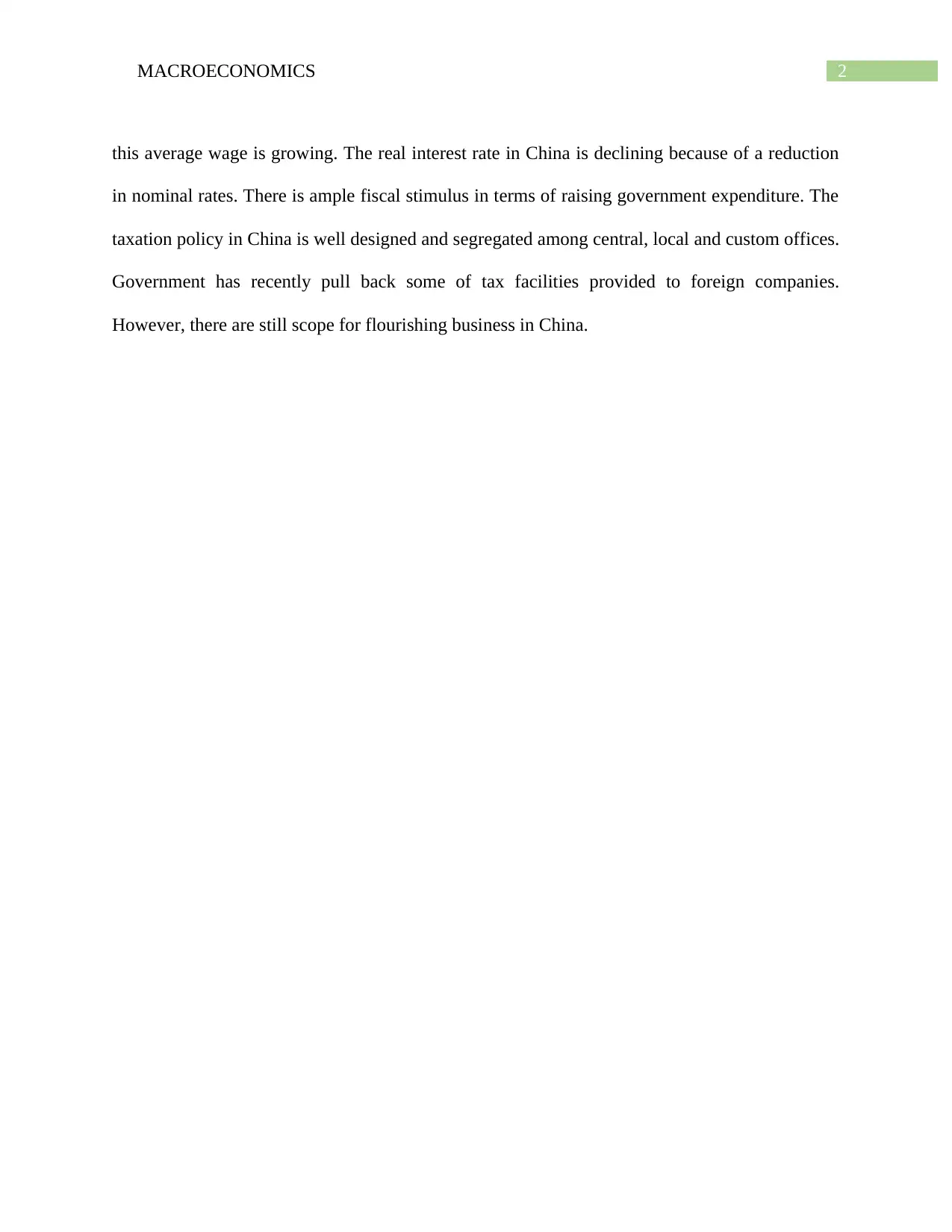
2MACROECONOMICS
this average wage is growing. The real interest rate in China is declining because of a reduction
in nominal rates. There is ample fiscal stimulus in terms of raising government expenditure. The
taxation policy in China is well designed and segregated among central, local and custom offices.
Government has recently pull back some of tax facilities provided to foreign companies.
However, there are still scope for flourishing business in China.
this average wage is growing. The real interest rate in China is declining because of a reduction
in nominal rates. There is ample fiscal stimulus in terms of raising government expenditure. The
taxation policy in China is well designed and segregated among central, local and custom offices.
Government has recently pull back some of tax facilities provided to foreign companies.
However, there are still scope for flourishing business in China.
⊘ This is a preview!⊘
Do you want full access?
Subscribe today to unlock all pages.

Trusted by 1+ million students worldwide
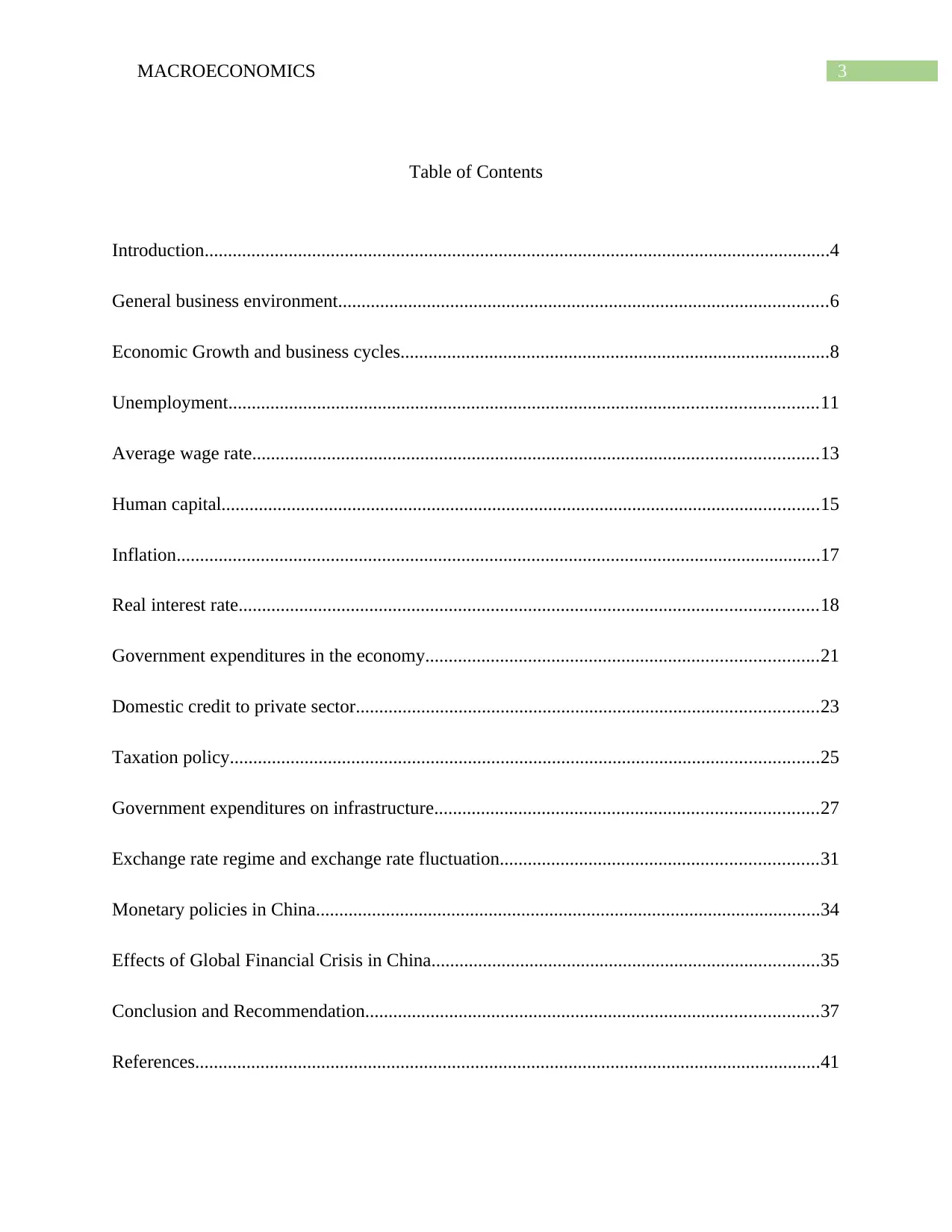
3MACROECONOMICS
Table of Contents
Introduction......................................................................................................................................4
General business environment.........................................................................................................6
Economic Growth and business cycles............................................................................................8
Unemployment..............................................................................................................................11
Average wage rate.........................................................................................................................13
Human capital................................................................................................................................15
Inflation..........................................................................................................................................17
Real interest rate............................................................................................................................18
Government expenditures in the economy....................................................................................21
Domestic credit to private sector...................................................................................................23
Taxation policy..............................................................................................................................25
Government expenditures on infrastructure..................................................................................27
Exchange rate regime and exchange rate fluctuation....................................................................31
Monetary policies in China............................................................................................................34
Effects of Global Financial Crisis in China...................................................................................35
Conclusion and Recommendation.................................................................................................37
References......................................................................................................................................41
Table of Contents
Introduction......................................................................................................................................4
General business environment.........................................................................................................6
Economic Growth and business cycles............................................................................................8
Unemployment..............................................................................................................................11
Average wage rate.........................................................................................................................13
Human capital................................................................................................................................15
Inflation..........................................................................................................................................17
Real interest rate............................................................................................................................18
Government expenditures in the economy....................................................................................21
Domestic credit to private sector...................................................................................................23
Taxation policy..............................................................................................................................25
Government expenditures on infrastructure..................................................................................27
Exchange rate regime and exchange rate fluctuation....................................................................31
Monetary policies in China............................................................................................................34
Effects of Global Financial Crisis in China...................................................................................35
Conclusion and Recommendation.................................................................................................37
References......................................................................................................................................41
Paraphrase This Document
Need a fresh take? Get an instant paraphrase of this document with our AI Paraphraser
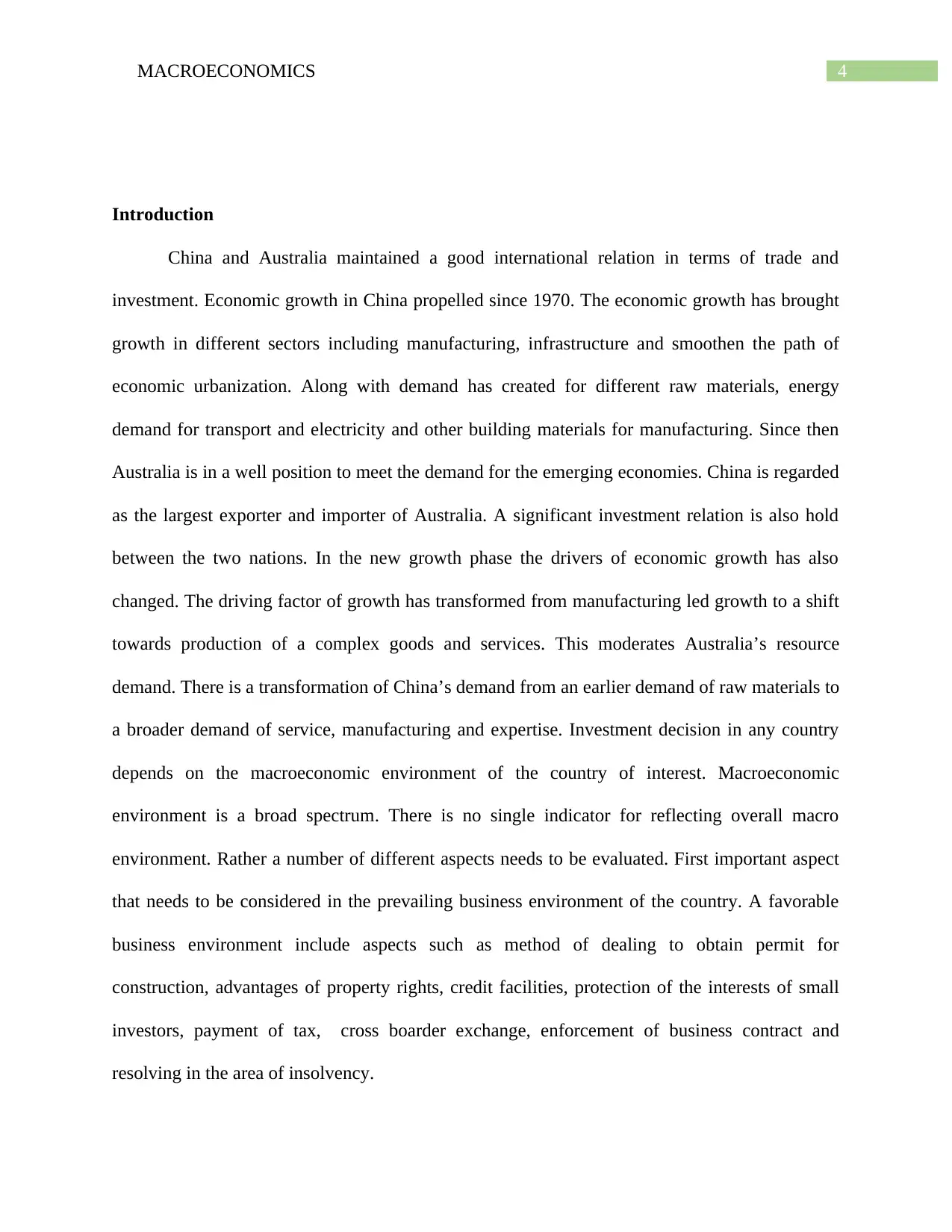
4MACROECONOMICS
Introduction
China and Australia maintained a good international relation in terms of trade and
investment. Economic growth in China propelled since 1970. The economic growth has brought
growth in different sectors including manufacturing, infrastructure and smoothen the path of
economic urbanization. Along with demand has created for different raw materials, energy
demand for transport and electricity and other building materials for manufacturing. Since then
Australia is in a well position to meet the demand for the emerging economies. China is regarded
as the largest exporter and importer of Australia. A significant investment relation is also hold
between the two nations. In the new growth phase the drivers of economic growth has also
changed. The driving factor of growth has transformed from manufacturing led growth to a shift
towards production of a complex goods and services. This moderates Australia’s resource
demand. There is a transformation of China’s demand from an earlier demand of raw materials to
a broader demand of service, manufacturing and expertise. Investment decision in any country
depends on the macroeconomic environment of the country of interest. Macroeconomic
environment is a broad spectrum. There is no single indicator for reflecting overall macro
environment. Rather a number of different aspects needs to be evaluated. First important aspect
that needs to be considered in the prevailing business environment of the country. A favorable
business environment include aspects such as method of dealing to obtain permit for
construction, advantages of property rights, credit facilities, protection of the interests of small
investors, payment of tax, cross boarder exchange, enforcement of business contract and
resolving in the area of insolvency.
Introduction
China and Australia maintained a good international relation in terms of trade and
investment. Economic growth in China propelled since 1970. The economic growth has brought
growth in different sectors including manufacturing, infrastructure and smoothen the path of
economic urbanization. Along with demand has created for different raw materials, energy
demand for transport and electricity and other building materials for manufacturing. Since then
Australia is in a well position to meet the demand for the emerging economies. China is regarded
as the largest exporter and importer of Australia. A significant investment relation is also hold
between the two nations. In the new growth phase the drivers of economic growth has also
changed. The driving factor of growth has transformed from manufacturing led growth to a shift
towards production of a complex goods and services. This moderates Australia’s resource
demand. There is a transformation of China’s demand from an earlier demand of raw materials to
a broader demand of service, manufacturing and expertise. Investment decision in any country
depends on the macroeconomic environment of the country of interest. Macroeconomic
environment is a broad spectrum. There is no single indicator for reflecting overall macro
environment. Rather a number of different aspects needs to be evaluated. First important aspect
that needs to be considered in the prevailing business environment of the country. A favorable
business environment include aspects such as method of dealing to obtain permit for
construction, advantages of property rights, credit facilities, protection of the interests of small
investors, payment of tax, cross boarder exchange, enforcement of business contract and
resolving in the area of insolvency.
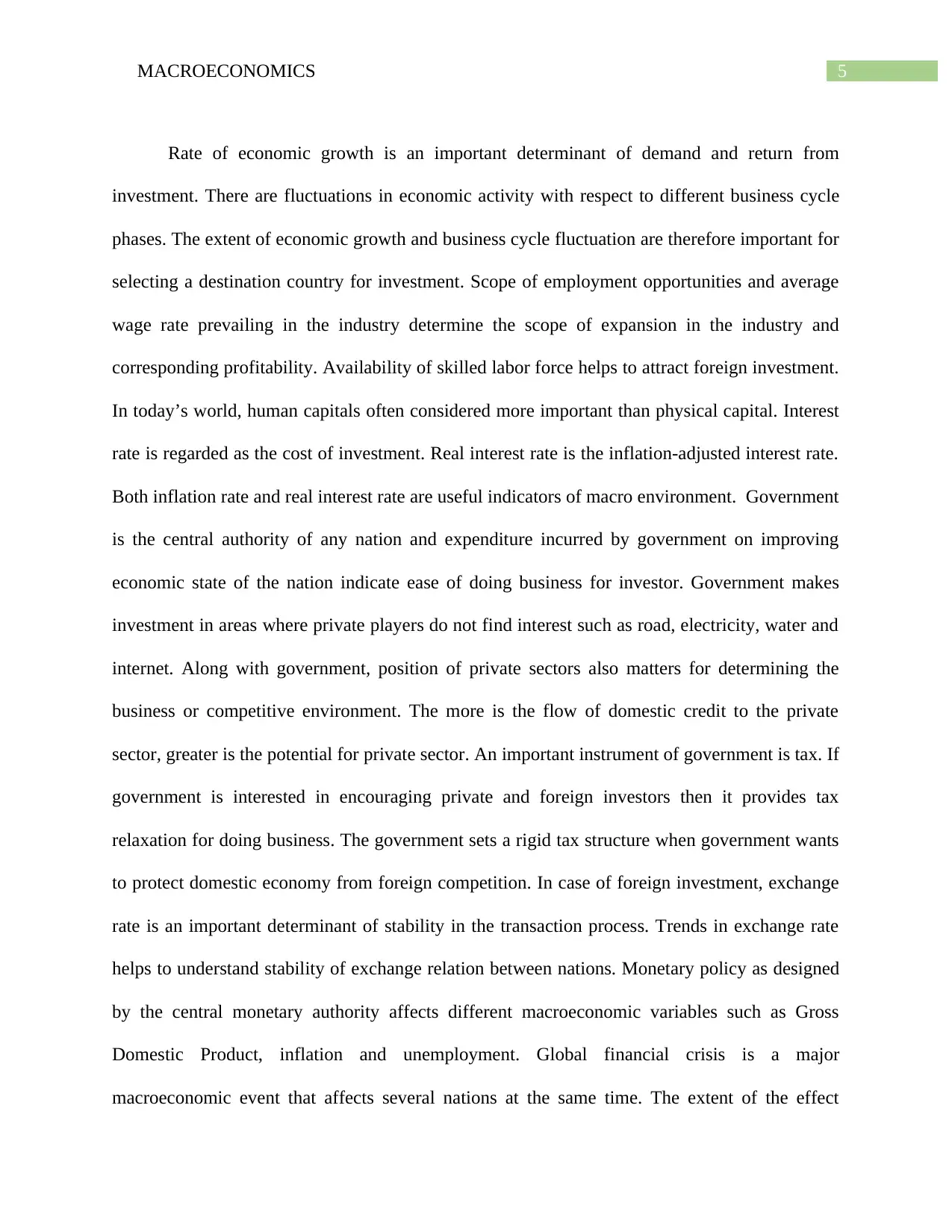
5MACROECONOMICS
Rate of economic growth is an important determinant of demand and return from
investment. There are fluctuations in economic activity with respect to different business cycle
phases. The extent of economic growth and business cycle fluctuation are therefore important for
selecting a destination country for investment. Scope of employment opportunities and average
wage rate prevailing in the industry determine the scope of expansion in the industry and
corresponding profitability. Availability of skilled labor force helps to attract foreign investment.
In today’s world, human capitals often considered more important than physical capital. Interest
rate is regarded as the cost of investment. Real interest rate is the inflation-adjusted interest rate.
Both inflation rate and real interest rate are useful indicators of macro environment. Government
is the central authority of any nation and expenditure incurred by government on improving
economic state of the nation indicate ease of doing business for investor. Government makes
investment in areas where private players do not find interest such as road, electricity, water and
internet. Along with government, position of private sectors also matters for determining the
business or competitive environment. The more is the flow of domestic credit to the private
sector, greater is the potential for private sector. An important instrument of government is tax. If
government is interested in encouraging private and foreign investors then it provides tax
relaxation for doing business. The government sets a rigid tax structure when government wants
to protect domestic economy from foreign competition. In case of foreign investment, exchange
rate is an important determinant of stability in the transaction process. Trends in exchange rate
helps to understand stability of exchange relation between nations. Monetary policy as designed
by the central monetary authority affects different macroeconomic variables such as Gross
Domestic Product, inflation and unemployment. Global financial crisis is a major
macroeconomic event that affects several nations at the same time. The extent of the effect
Rate of economic growth is an important determinant of demand and return from
investment. There are fluctuations in economic activity with respect to different business cycle
phases. The extent of economic growth and business cycle fluctuation are therefore important for
selecting a destination country for investment. Scope of employment opportunities and average
wage rate prevailing in the industry determine the scope of expansion in the industry and
corresponding profitability. Availability of skilled labor force helps to attract foreign investment.
In today’s world, human capitals often considered more important than physical capital. Interest
rate is regarded as the cost of investment. Real interest rate is the inflation-adjusted interest rate.
Both inflation rate and real interest rate are useful indicators of macro environment. Government
is the central authority of any nation and expenditure incurred by government on improving
economic state of the nation indicate ease of doing business for investor. Government makes
investment in areas where private players do not find interest such as road, electricity, water and
internet. Along with government, position of private sectors also matters for determining the
business or competitive environment. The more is the flow of domestic credit to the private
sector, greater is the potential for private sector. An important instrument of government is tax. If
government is interested in encouraging private and foreign investors then it provides tax
relaxation for doing business. The government sets a rigid tax structure when government wants
to protect domestic economy from foreign competition. In case of foreign investment, exchange
rate is an important determinant of stability in the transaction process. Trends in exchange rate
helps to understand stability of exchange relation between nations. Monetary policy as designed
by the central monetary authority affects different macroeconomic variables such as Gross
Domestic Product, inflation and unemployment. Global financial crisis is a major
macroeconomic event that affects several nations at the same time. The extent of the effect
⊘ This is a preview!⊘
Do you want full access?
Subscribe today to unlock all pages.

Trusted by 1+ million students worldwide
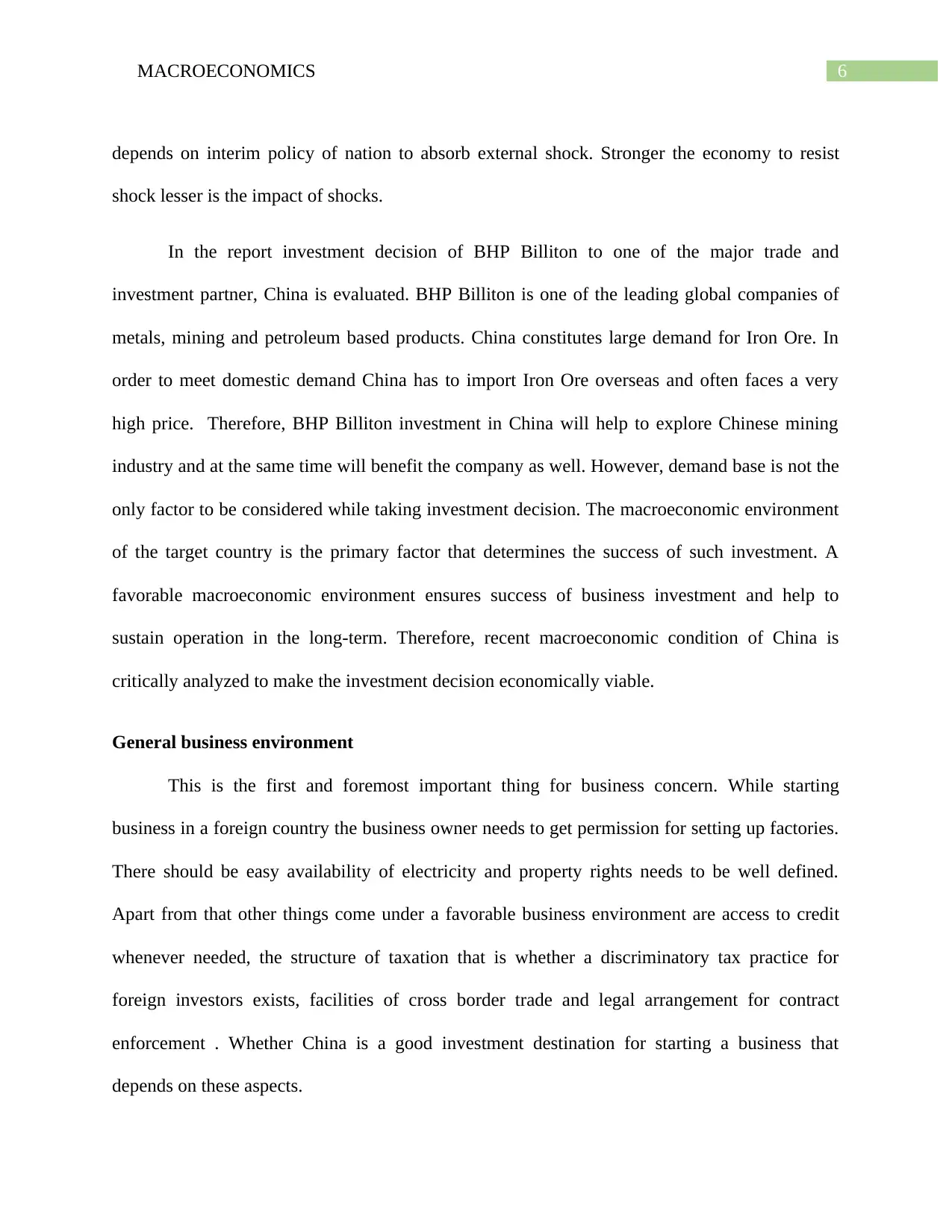
6MACROECONOMICS
depends on interim policy of nation to absorb external shock. Stronger the economy to resist
shock lesser is the impact of shocks.
In the report investment decision of BHP Billiton to one of the major trade and
investment partner, China is evaluated. BHP Billiton is one of the leading global companies of
metals, mining and petroleum based products. China constitutes large demand for Iron Ore. In
order to meet domestic demand China has to import Iron Ore overseas and often faces a very
high price. Therefore, BHP Billiton investment in China will help to explore Chinese mining
industry and at the same time will benefit the company as well. However, demand base is not the
only factor to be considered while taking investment decision. The macroeconomic environment
of the target country is the primary factor that determines the success of such investment. A
favorable macroeconomic environment ensures success of business investment and help to
sustain operation in the long-term. Therefore, recent macroeconomic condition of China is
critically analyzed to make the investment decision economically viable.
General business environment
This is the first and foremost important thing for business concern. While starting
business in a foreign country the business owner needs to get permission for setting up factories.
There should be easy availability of electricity and property rights needs to be well defined.
Apart from that other things come under a favorable business environment are access to credit
whenever needed, the structure of taxation that is whether a discriminatory tax practice for
foreign investors exists, facilities of cross border trade and legal arrangement for contract
enforcement . Whether China is a good investment destination for starting a business that
depends on these aspects.
depends on interim policy of nation to absorb external shock. Stronger the economy to resist
shock lesser is the impact of shocks.
In the report investment decision of BHP Billiton to one of the major trade and
investment partner, China is evaluated. BHP Billiton is one of the leading global companies of
metals, mining and petroleum based products. China constitutes large demand for Iron Ore. In
order to meet domestic demand China has to import Iron Ore overseas and often faces a very
high price. Therefore, BHP Billiton investment in China will help to explore Chinese mining
industry and at the same time will benefit the company as well. However, demand base is not the
only factor to be considered while taking investment decision. The macroeconomic environment
of the target country is the primary factor that determines the success of such investment. A
favorable macroeconomic environment ensures success of business investment and help to
sustain operation in the long-term. Therefore, recent macroeconomic condition of China is
critically analyzed to make the investment decision economically viable.
General business environment
This is the first and foremost important thing for business concern. While starting
business in a foreign country the business owner needs to get permission for setting up factories.
There should be easy availability of electricity and property rights needs to be well defined.
Apart from that other things come under a favorable business environment are access to credit
whenever needed, the structure of taxation that is whether a discriminatory tax practice for
foreign investors exists, facilities of cross border trade and legal arrangement for contract
enforcement . Whether China is a good investment destination for starting a business that
depends on these aspects.
Paraphrase This Document
Need a fresh take? Get an instant paraphrase of this document with our AI Paraphraser
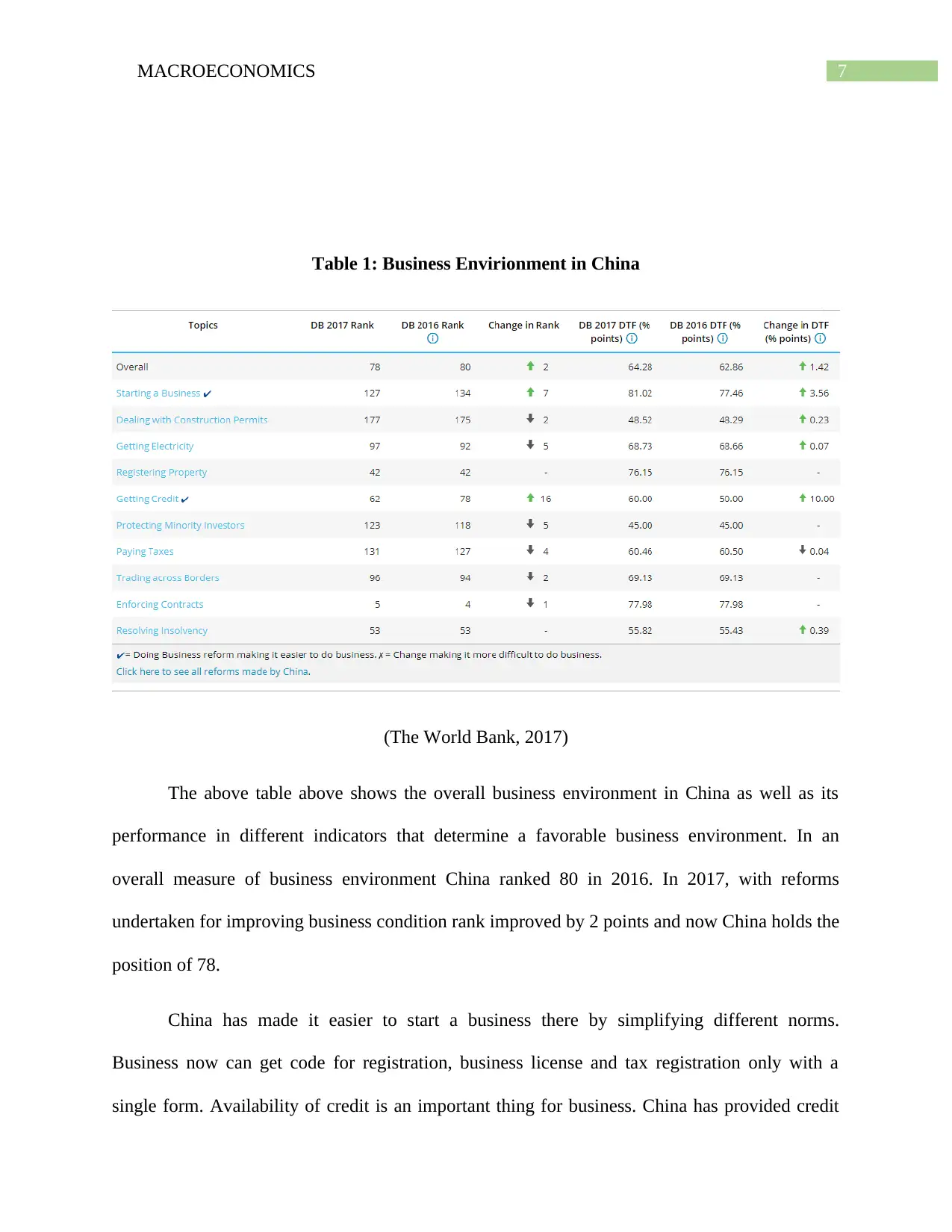
7MACROECONOMICS
Table 1: Business Envirionment in China
(The World Bank, 2017)
The above table above shows the overall business environment in China as well as its
performance in different indicators that determine a favorable business environment. In an
overall measure of business environment China ranked 80 in 2016. In 2017, with reforms
undertaken for improving business condition rank improved by 2 points and now China holds the
position of 78.
China has made it easier to start a business there by simplifying different norms.
Business now can get code for registration, business license and tax registration only with a
single form. Availability of credit is an important thing for business. China has provided credit
Table 1: Business Envirionment in China
(The World Bank, 2017)
The above table above shows the overall business environment in China as well as its
performance in different indicators that determine a favorable business environment. In an
overall measure of business environment China ranked 80 in 2016. In 2017, with reforms
undertaken for improving business condition rank improved by 2 points and now China holds the
position of 78.
China has made it easier to start a business there by simplifying different norms.
Business now can get code for registration, business license and tax registration only with a
single form. Availability of credit is an important thing for business. China has provided credit
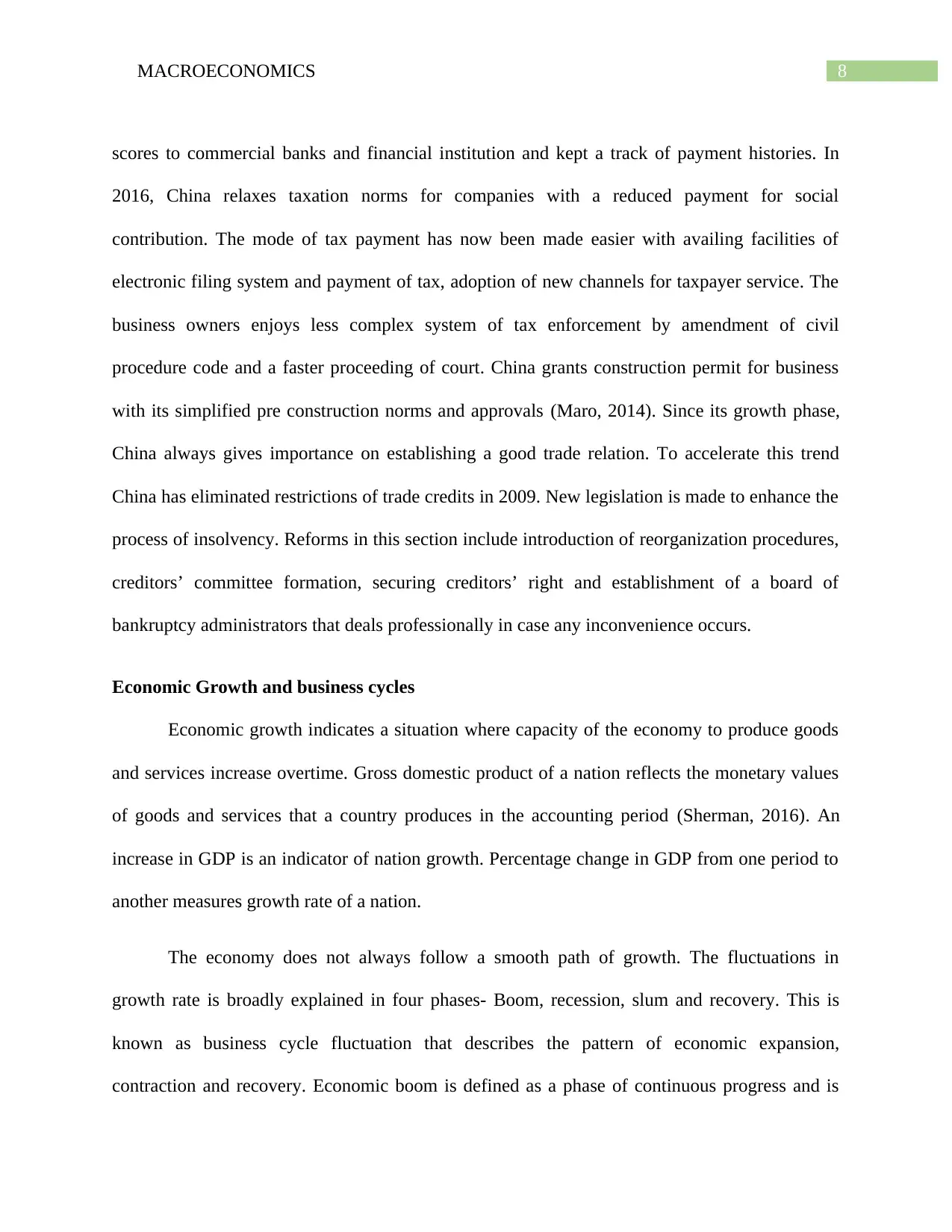
8MACROECONOMICS
scores to commercial banks and financial institution and kept a track of payment histories. In
2016, China relaxes taxation norms for companies with a reduced payment for social
contribution. The mode of tax payment has now been made easier with availing facilities of
electronic filing system and payment of tax, adoption of new channels for taxpayer service. The
business owners enjoys less complex system of tax enforcement by amendment of civil
procedure code and a faster proceeding of court. China grants construction permit for business
with its simplified pre construction norms and approvals (Maro, 2014). Since its growth phase,
China always gives importance on establishing a good trade relation. To accelerate this trend
China has eliminated restrictions of trade credits in 2009. New legislation is made to enhance the
process of insolvency. Reforms in this section include introduction of reorganization procedures,
creditors’ committee formation, securing creditors’ right and establishment of a board of
bankruptcy administrators that deals professionally in case any inconvenience occurs.
Economic Growth and business cycles
Economic growth indicates a situation where capacity of the economy to produce goods
and services increase overtime. Gross domestic product of a nation reflects the monetary values
of goods and services that a country produces in the accounting period (Sherman, 2016). An
increase in GDP is an indicator of nation growth. Percentage change in GDP from one period to
another measures growth rate of a nation.
The economy does not always follow a smooth path of growth. The fluctuations in
growth rate is broadly explained in four phases- Boom, recession, slum and recovery. This is
known as business cycle fluctuation that describes the pattern of economic expansion,
contraction and recovery. Economic boom is defined as a phase of continuous progress and is
scores to commercial banks and financial institution and kept a track of payment histories. In
2016, China relaxes taxation norms for companies with a reduced payment for social
contribution. The mode of tax payment has now been made easier with availing facilities of
electronic filing system and payment of tax, adoption of new channels for taxpayer service. The
business owners enjoys less complex system of tax enforcement by amendment of civil
procedure code and a faster proceeding of court. China grants construction permit for business
with its simplified pre construction norms and approvals (Maro, 2014). Since its growth phase,
China always gives importance on establishing a good trade relation. To accelerate this trend
China has eliminated restrictions of trade credits in 2009. New legislation is made to enhance the
process of insolvency. Reforms in this section include introduction of reorganization procedures,
creditors’ committee formation, securing creditors’ right and establishment of a board of
bankruptcy administrators that deals professionally in case any inconvenience occurs.
Economic Growth and business cycles
Economic growth indicates a situation where capacity of the economy to produce goods
and services increase overtime. Gross domestic product of a nation reflects the monetary values
of goods and services that a country produces in the accounting period (Sherman, 2016). An
increase in GDP is an indicator of nation growth. Percentage change in GDP from one period to
another measures growth rate of a nation.
The economy does not always follow a smooth path of growth. The fluctuations in
growth rate is broadly explained in four phases- Boom, recession, slum and recovery. This is
known as business cycle fluctuation that describes the pattern of economic expansion,
contraction and recovery. Economic boom is defined as a phase of continuous progress and is
⊘ This is a preview!⊘
Do you want full access?
Subscribe today to unlock all pages.

Trusted by 1+ million students worldwide
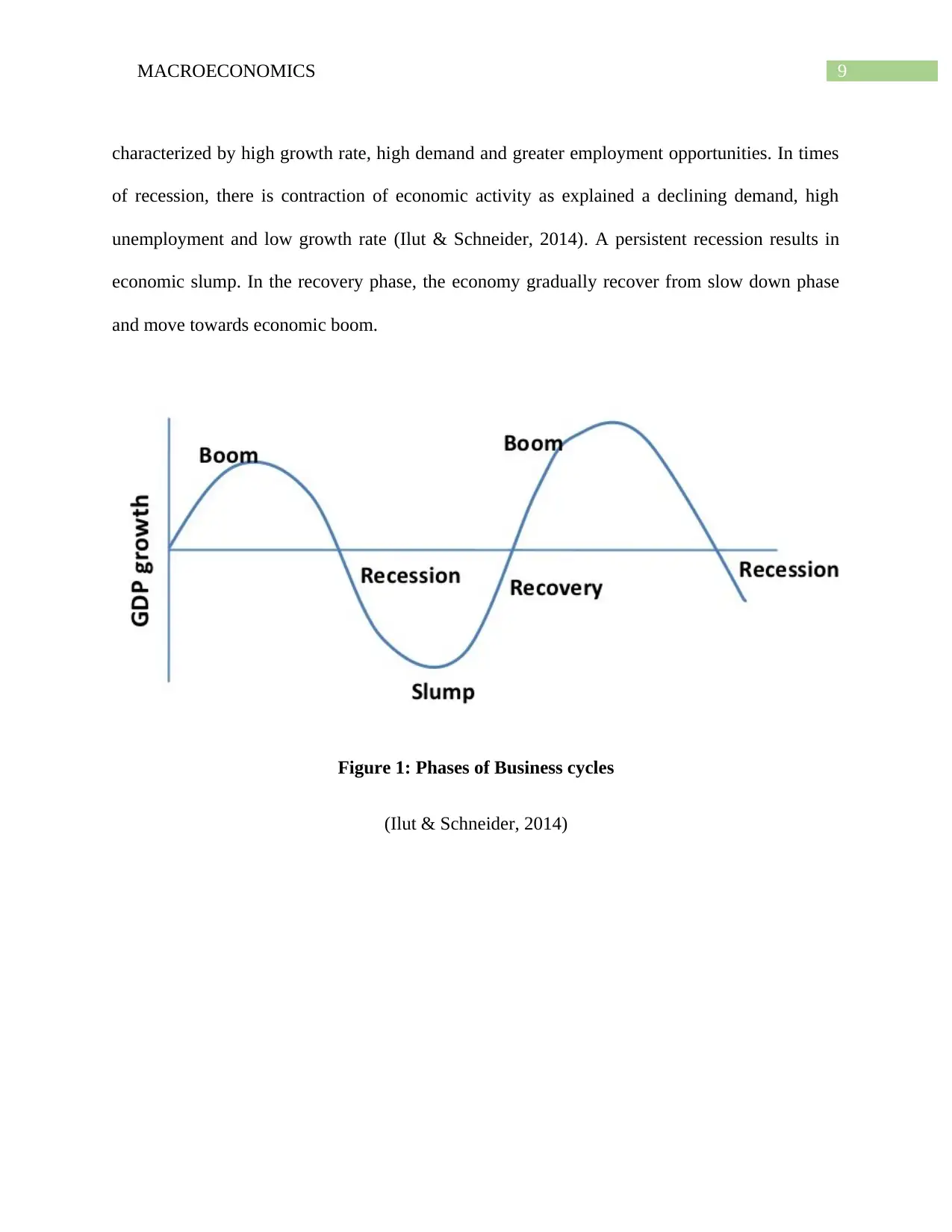
9MACROECONOMICS
characterized by high growth rate, high demand and greater employment opportunities. In times
of recession, there is contraction of economic activity as explained a declining demand, high
unemployment and low growth rate (Ilut & Schneider, 2014). A persistent recession results in
economic slump. In the recovery phase, the economy gradually recover from slow down phase
and move towards economic boom.
Figure 1: Phases of Business cycles
(Ilut & Schneider, 2014)
characterized by high growth rate, high demand and greater employment opportunities. In times
of recession, there is contraction of economic activity as explained a declining demand, high
unemployment and low growth rate (Ilut & Schneider, 2014). A persistent recession results in
economic slump. In the recovery phase, the economy gradually recover from slow down phase
and move towards economic boom.
Figure 1: Phases of Business cycles
(Ilut & Schneider, 2014)
Paraphrase This Document
Need a fresh take? Get an instant paraphrase of this document with our AI Paraphraser
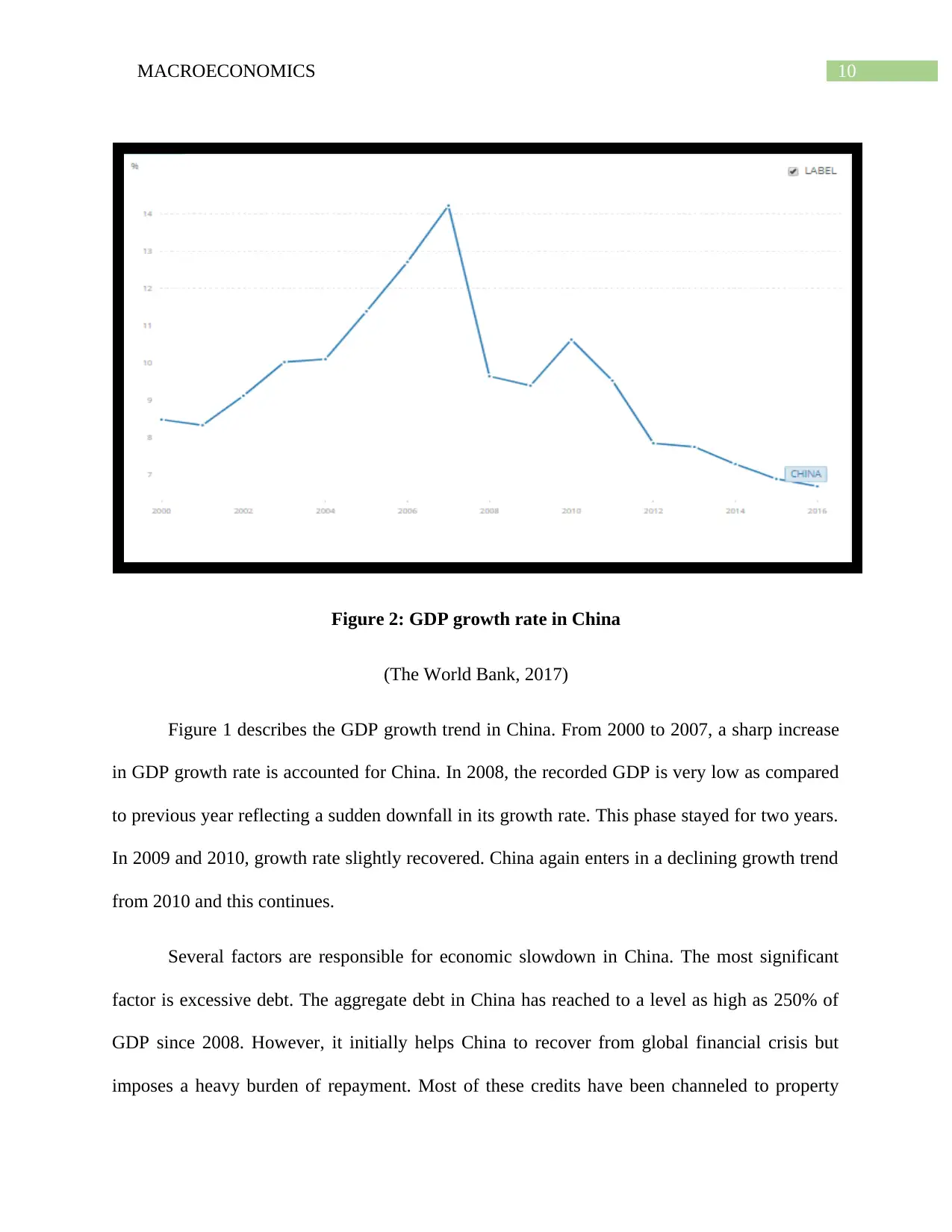
10MACROECONOMICS
Figure 2: GDP growth rate in China
(The World Bank, 2017)
Figure 1 describes the GDP growth trend in China. From 2000 to 2007, a sharp increase
in GDP growth rate is accounted for China. In 2008, the recorded GDP is very low as compared
to previous year reflecting a sudden downfall in its growth rate. This phase stayed for two years.
In 2009 and 2010, growth rate slightly recovered. China again enters in a declining growth trend
from 2010 and this continues.
Several factors are responsible for economic slowdown in China. The most significant
factor is excessive debt. The aggregate debt in China has reached to a level as high as 250% of
GDP since 2008. However, it initially helps China to recover from global financial crisis but
imposes a heavy burden of repayment. Most of these credits have been channeled to property
Figure 2: GDP growth rate in China
(The World Bank, 2017)
Figure 1 describes the GDP growth trend in China. From 2000 to 2007, a sharp increase
in GDP growth rate is accounted for China. In 2008, the recorded GDP is very low as compared
to previous year reflecting a sudden downfall in its growth rate. This phase stayed for two years.
In 2009 and 2010, growth rate slightly recovered. China again enters in a declining growth trend
from 2010 and this continues.
Several factors are responsible for economic slowdown in China. The most significant
factor is excessive debt. The aggregate debt in China has reached to a level as high as 250% of
GDP since 2008. However, it initially helps China to recover from global financial crisis but
imposes a heavy burden of repayment. Most of these credits have been channeled to property
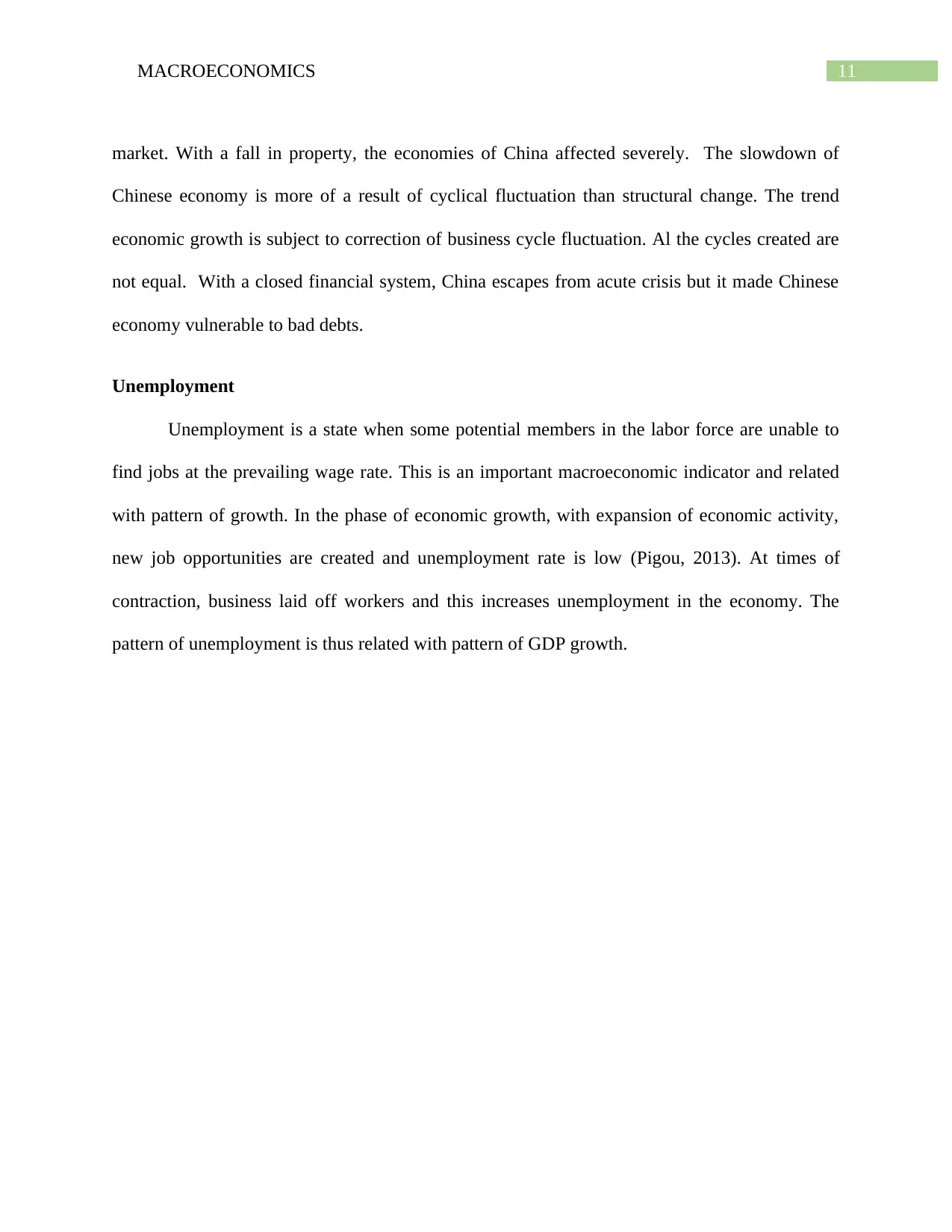
11MACROECONOMICS
market. With a fall in property, the economies of China affected severely. The slowdown of
Chinese economy is more of a result of cyclical fluctuation than structural change. The trend
economic growth is subject to correction of business cycle fluctuation. Al the cycles created are
not equal. With a closed financial system, China escapes from acute crisis but it made Chinese
economy vulnerable to bad debts.
Unemployment
Unemployment is a state when some potential members in the labor force are unable to
find jobs at the prevailing wage rate. This is an important macroeconomic indicator and related
with pattern of growth. In the phase of economic growth, with expansion of economic activity,
new job opportunities are created and unemployment rate is low (Pigou, 2013). At times of
contraction, business laid off workers and this increases unemployment in the economy. The
pattern of unemployment is thus related with pattern of GDP growth.
market. With a fall in property, the economies of China affected severely. The slowdown of
Chinese economy is more of a result of cyclical fluctuation than structural change. The trend
economic growth is subject to correction of business cycle fluctuation. Al the cycles created are
not equal. With a closed financial system, China escapes from acute crisis but it made Chinese
economy vulnerable to bad debts.
Unemployment
Unemployment is a state when some potential members in the labor force are unable to
find jobs at the prevailing wage rate. This is an important macroeconomic indicator and related
with pattern of growth. In the phase of economic growth, with expansion of economic activity,
new job opportunities are created and unemployment rate is low (Pigou, 2013). At times of
contraction, business laid off workers and this increases unemployment in the economy. The
pattern of unemployment is thus related with pattern of GDP growth.
⊘ This is a preview!⊘
Do you want full access?
Subscribe today to unlock all pages.

Trusted by 1+ million students worldwide
1 out of 44
Related Documents
Your All-in-One AI-Powered Toolkit for Academic Success.
+13062052269
info@desklib.com
Available 24*7 on WhatsApp / Email
![[object Object]](/_next/static/media/star-bottom.7253800d.svg)
Unlock your academic potential
Copyright © 2020–2025 A2Z Services. All Rights Reserved. Developed and managed by ZUCOL.





